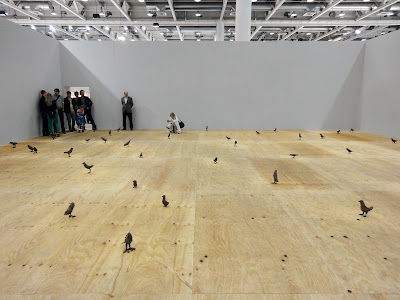If you have been to Art Basel, you would probably know that Art Unlimited is usually a better sector of the fair – less commercial with more ambitious large installations. This year, Art Unlimited presented 60+ pieces, from big sculptures to large photo prints to video art, from classics in the 60s to the most recent works of the year.
Just beyond the entrance was Damián Ortega’s Architecture without Architects. As usual Ortega, the found elements were hung apart from each other. But this time, furniture and building parts stood still at where they were supposed to be in a three-story house, lacking the explosive power of his Cosmic Thing or the intensity created by the knives in Controller of the Universe. Not far from Ortega was Chris Burden’s typical Erector Set construction. A bit further in was Franz West’s mammoth Gekröse (largest sculpture he had created to date). It looked like an upset intestinal tract, but I kind of liked its playfulness. Thomas Ruff presented a large print from his new ma.r.s. series, in which photos were created from NASA images with manipulated perspective and color. Mike Nelson reconstructed the shrine-like After Kerouac (2006). For some while I thought it was a version of Allan Kaprow’s Yard (1961). David Zwirner reenacted their 2009 “Thousand” exhibition featuring Philip-Lorca diCorcia’s 1000 Polaroid photos from the late 1970s to the early 2000s. Italian Arte Povera master Pier Paolo Calzolari’s historic untitled piece was also shown. It consisted of six white mattresses filled with swan’s down and supported upright on a surface of lead with a refrigerating mechanism that created a layer of frost. The povera piece was marked with a not-so-povera price of €1 million.
 |
| Damián Ortega, Architecture without Architects, 2010 |
 |
| Chris Burden, Curved Bridge, 2003 |
 |
| Franz West, Gekröse, 2011 |
 |
| Thomas Ruff, ma.r.s.13, 2011 |
 |
| Mike Nelson’s After Kerouac starts with a spiral passage |
 |
| Mike Nelson, After Kerouac, 2006 |
 |
| Philip-Lorca diCorcia, Thousand |
 |
| Pier Paolo Calzolari, Untitled, 1970/94 |
This part of Art Basel is called “unlimited” because it is supposed to be the “pioneering exhibition platform for projects that transcend the classical art-show stand.” But this year’s ensemble still didn’t go beyond the limits of the trade fair context. You just could not forget the fact that you were in a Messe hall with slick glass curtain wall and steel trusses. I had seen Phyllida Barlow’s Stage meandering between columns in Haus der Kunst in Munich, instead of standing between white boxes in a trade fair. Ugo Rondinone’s 59 lead birds were nice. But compared to Maurizio Cattelan populating the Central Pavilion in Giardini with his stuffed pigeons last year, Primitive seemed rather underwhelming. When Gilbert & George’s London Pictures were shown at Lehmann Maupin in New York last year, the series spanned across many topics and delivered a more thorough and critical portrayal of our current society and city life. But trade fair also had its positive side – at least I didn’t need to worry about Robert Morris’s classic Scatter Piece going to the trash again, with its price tag at $1.45 million awaiting potential buyers.
 |
| Phyllida Barlow, Untitled: Stage, 2011 |
 |
| Ugo Rondinone, Primitive, 2011 |
 |
| Gilbert & George, London Pictures, 2011 |
 |
| Robert Morris, Untitled (Scatter Piece), 1968-69 |
Of course, the limitation had to do with the quality of works as well. The glossy pink pig, among many others, seemed very stupid and shallow.
 |
| Richard Jackson, Big Pig, 2009-10 |
 |
| Raqs Media Collective, Revoltage, 2011 |
My favorite piece though was Ricci Albenda’s Open Universe – a three-dimensional drawing with lines made from delicate bent willow ribs. It revealed an almost architectural space while simultaneously playing with perspectives. In You and My Friends, Ryan McGinley captured the faces of awed fans at various outdoor summer music festivals in the US and Europe. This 5x11 grid of portraits showed the sensibility of the rising star of photography, his explorations of youthful emotions that were, as the title suggested, deeply personal and yet extremely collective.
 |
| Ricci Albenda, Open Universe (Indra), 2011 |
 |
| Ryan McGinley, You and My Friends, 2011-12 |







No comments:
Post a Comment